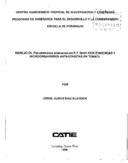| dc.contributor.advisor | Bustamante, Elkin | es_ES |
| dc.contributor.author | Díaz Blandón, Jorge U. | |
| dc.date.accessioned | 2020-11-13T20:08:12Z | |
| dc.date.available | 2020-11-13T20:08:12Z | |
| dc.date.issued | 1999 | |
| dc.identifier.uri | https://repositorio.catie.ac.cr/handle/11554/9936 | |
| dc.description | Tesis (Mag Sc)--CATIE, Turrialba (Costa Rica) 1999 | es_ES |
| dc.description | Ilustraciones. Tablas | |
| dc.description | Referencias de las páginas 87-103 | |
| dc.description.abstract | El objetivo fundamental de este estudio file el de evaluar el efecto de enmiendas y antagonistas sobre la marchitez bacteriana en el campo y en invernadero. Las enmiendas utilizadas compost comercial y cal dolomítica. Los microorganismos antagonistas fueron pseudonomas cepacia, Bacillus cereus y Glomus occultum. Se realizaron tres experimentos, uno de campo y dos de invernadero.
Para los tres experimentos se utilizó un diseño de parcelas divididas con cuatro repeticiones para el experimento de campo y tres repeticiones para los experimentos de invernadero. En el campo, los tratamientos con y sin enmiendas (3) se ubicaron en las parcelas principales, dispuestas en bloques completamente al azar y los tratamientos con microorganismos antagonistas (8) se asignaron a las subparcelas- En el invernadero, los tratamientos sustratos con y sin enmiendas (3) se asignaron a las parcelas principales, mientras que los tratamientos con microorganismos antagonistas (9) se ubicaron en las subparcelas. Las variables de respuesta evaluadas en el campo fueron incidencia, severidad de la enfermedad y ABCPE En el invernadero las variables fueron severidad de la enfermedad, ABCPE, altura, diámetro y biomasa de las plantas de tomate | es_ES |
| dc.description.abstract | The main purpose of this study was to evaluate the effect of soil amendments and antagonista microorganism on bacterial wilt in field and greenhouse conditions. Compost and dolomitic lime were used as oíl amendments. Pseudonomas cepacia, Bacillus cereus and Glomus occultum were used as microorganisms. Three experiments were conducted, a field experiment and two geenhouse split-plot design with four replications (field experiment) or three replications (greenhouse experiments) was used. The treatments substrates (3) with and without amendments were assigned to main plots, which were • arranged as a randomized complete block, and the treatments with antagonistic microorganisms (8) wae assigned to subplots in the field experiment. The treatments substrates (3) with and without were assigned to main plots, while the treatments with antagonistic microorganisms (9) were assigned to subplots in the greenhouse experiments. The response variables in the field were disease incidence severity and AUDPC In the greenhouse the variables evaluated were disease severity, AUDPC, height, diameter and biomass of the tomato plants. | |
| dc.format.extent | 124 páginas | |
| dc.language.iso | es | es_ES |
| dc.publisher | CATIE, Turriaba (Costa Rica) | es_ES |
| dc.subject | MARCHITEZ BACTERIANA | |
| dc.subject | MICROORGANISMO ANTAGONISTAS | |
| dc.subject | ENMIENDA | |
| dc.subject | INCIDENCIA | |
| dc.subject | SEVERIDAD | |
| dc.subject | BIOMASA | |
| dc.subject | PSEUDOMONAS SOLANACEARUM | |
| dc.subject | PSEUDOMONAS CEPACIA | |
| dc.subject | BACILLUS CEREUS | |
| dc.subject | GLOMUS OCCULTUM | |
| dc.subject | PATOGENICIDAD | |
| dc.subject | TOMATE | |
| dc.subject | BACTERIZACIÓN | |
| dc.title | Manejo de pseudomonas solanacearum E.F Smith con enmiendas y microorganismos antagonistas en tomate | es_ES |
| dc.type | Tesis | es_ES |


